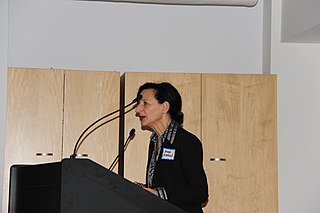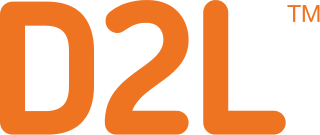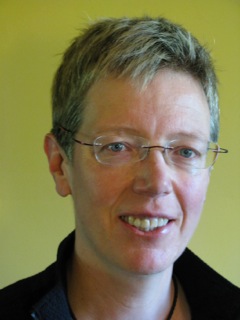Related Research Articles
The World Wide Web Consortium (W3C)'s Web Accessibility Initiative (WAI) is an effort to improve the accessibility of the World Wide Web for people with disabilities. People with disabilities may encounter difficulties when using computers generally, but also on the Web. Since people with disabilities often require non-standard devices and browsers, making websites more accessible also benefits a wide range of user agents and devices, including mobile devices, which have limited resources.

Accessibility in the sense considered here refers to the design of products, devices, services, or environments so as to be usable by people with disabilities. The concept of accessible design and practice of accessible development ensures both "direct access" and "indirect access" meaning compatibility with a person's assistive technology.

Ontario College of Art & Design University, commonly known as OCAD University, is a public university of art and design located in Toronto, Ontario, Canada. The main campus is adjacent to the Art Gallery of Ontario, within the Grange Park neighbourhood. The school is Canada's largest and oldest educational institution for art and design. OCAD U offers courses through the Faculties of Art, Design, Liberal Arts and Sciences, and alternative programs. The enabling legislation is the Ontario College of Art and Design University Act, 2002.
Universal design is the design of buildings, products or environments to make them accessible to all people, regardless of age, disability or other factors.
Web accessibility is the inclusive practice of ensuring there are no barriers that prevent interaction with, or access to, websites on the World Wide Web by people with physical disabilities, situational disabilities, and socio-economic restrictions on bandwidth and speed. When sites are correctly designed, developed and edited, generally all users have equal access to information and functionality.
Inclusive design is a design process in which a product, service or environment is optimized for a specific user with specific needs. Usually, this user is an extreme user, meaning that this user has specific needs that are sometimes overseen with other design processes. By focusing on the extreme users, Inclusive design will enable them to be able to use it, while many users having (temporary) similar needs will also be covered.

ATutor is an Open Source Web-based Learning Content Management System (LCMS).
Claroline is a collaborative eLearning and eWorking platform released under the GPL open-source license. It allows hundreds of organizations worldwide ranging from universities to schools and from companies to associations to create and administer courses and collaboration spaces over the web. The platform is used in more than 100 countries and is available in 35 languages.

The Council of Ontario Universities (COU) is the voice of Ontario's universities, promoting the value of education, research and innovation that leads to social, cultural and economic success. A membership organization consisting of Ontario's 20 publicly assisted universities and one associate member, the Royal Military College of Canada, COU works with members to find consensus on a wide range of university issues and advances them with government and other stakeholders.
The Rix Centre is a British charitable research and development centre that was founded in 2004. The Centre, based at the University of East London, explores the uses of new media technology for the benefit of the learning disability community. It has developed multimedia technologies and courses to support those with learning disabilities and their careers.

Agropedia is an online knowledge repository for information related to agriculture in India. It includes universal meta models and localized content for a variety of users with appropriate interfaces built in collaborative mode in multiple languages. This national portal, designed as an "agricultural Wikipedia" hosts wide range of agricultural information on a variety of crops, with an aim to empower farmers with crop information.
Design for All in the context of information and communications technology (ICT) is the conscious and systematic effort to proactively apply principles, methods and tools to promote universal design in computer-related technologies, including Internet-based technologies, thus avoiding the need for a posteriori adaptations, or specialised design.
The European Platform for Rehabilitation (EPR) is a network of European providers of rehabilitation services to people with disabilities and other disadvantaged groups. EPR members deliver services in the fields of vocational training and education, reintegration of service users into the open labour market and improvement of their employability, physical rehabilitation and social care.

Sara Louise Diamond, is a Canadian artist and was the president of OCAD University, Canada.

D2L is a global software company with offices in the United States, Canada, Singapore, Australia, Europe, and Brazil. It is the developer of the Brightspace learning management system, which is a cloud-based software suite used by schools, institutes of higher education, and businesses for online and blended classroom learning. D2L is the developer of Open Courses, a Massive Open Online Course platform. The acronym D2L stands for Desire 2 Learn.

OER Commons is a freely accessible online library that allows teachers and others to search and discover open educational resources (OER) and other freely available instructional materials.

Jutta Treviranus is a full Professor at the Ontario College of Art and Design University (OCADU) in Toronto, Canada. She is the Director and Founder of the Inclusive Design Research Centre (IDRC) and the Inclusive Design Institute (IDI).
Wendy Coburn was a Canadian artist and professor at the Ontario College of Art and Design University. She is known for her sculptures and for her video-based show "Anatomy of a Protest" (2014).
Open educational resources in Canada are the various initiatives related to open educational resources (OER) and open education established nationally and provincially in Canada, and with international collaboration.
Elizabeth 'Liddy' Nevile is an Australian academic and a pioneer in using computers and the World Wide Web for education in Australia. In 1989-1990 she was instrumental in establishing the first program in the world that required all students to have laptop computers, at Methodist Ladies College, Melbourne, Australia.
References
- 1 2 Kochany, Kaitlyn (September 25, 2013). "I Want Your Job: Jutta Treviranus, Director of the Inclusive Design Research Centre". Torontoist . Retrieved June 3, 2014.
After starting the Adaptive Technology Resource Centre at the University of Toronto in 1994, Treviranus moved it to OCADU in 2010 and rebranded it as the IDRC.
- ↑ "The Adaptive Technology Resource Centre" (PDF). Augmentative Communications News. 8 (2): 7. March–April 1995. Retrieved July 28, 2013.
The Adaptive Technology Resource Centre (ATRC), located at the University of Toronto, opened in September, 1994
- ↑ Canadian National Institute for the Blind (June 15, 2005). "2005 Recipient: University of Toronto, Adaptive Technology Resource Centre (ATRC)". Archived from the original on June 6, 2014. Retrieved June 3, 2014.
The ATRC was established in 1994
- ↑ "Jutta TREVIRANUS". European Commission: ICT 2013. Retrieved June 3, 2014.
With its origins in the Adaptive Technology Resource Centre established in 1993, the IDRC is….
- 1 2 "Staff Pages: Jutta Treviranus (Director)". Inclusive Design Research Centre, OCAD University. Retrieved June 3, 2014.
With the help of a many individuals and organizations I established the then "Adaptive Technology Resource Centre" (ATRC) in 1993 at the University of Toronto.…Thanks to talented staff, many of whom are students, the ATRC, now the Inclusive Design Research Centre at OCAD University, continues to meet these expectations.
- ↑ "Staff pages". Inclusive Design Research Centre, OCAD University. Retrieved June 3, 2014.
- ↑ "What is a Learning Management System?". University of Toronto . Retrieved June 3, 2014.
ATutor was developed by U of T's Adaptive Technology Resource Centre, which was renamed the Inclusive Design Research Centre and relocated to OCAD University August 1, 2010.
- ↑ Raising the Floor. "Jutta Treviranus". Archived from the original on June 7, 2014. Retrieved June 3, 2014.
Jutta Treviranus is the Director of the Inclusive Design Research Centre (IDRC) and professor at OCAD University in Toronto, formerly the Adaptive Technology Resource Centre.
- ↑ "About the IDRC". Inclusive Design Research Centre (OCAD University). Retrieved 30 January 2014.
- ↑ "Staff Pages". Inclusive Design Research Centre (OCAD University). Retrieved 30 January 2014.
- ↑ Law, Jaclyn (March 30, 2011). "OCAD U Sees an Accessible Future with New Master Program in Inclusive Design". Accessibility for Ontarians with Disabilities Act (AODA). aoda.ca.
- ↑ "Master's Program". Inclusive Design Research Centre (OCAD University). Archived from the original on 2 February 2014. Retrieved 30 January 2014.
- ↑ "Flexible Learning for Open Education". Inclusive Design Research Centre. Retrieved April 23, 2014.
- 1 2 3 "New Projects". Inclusive Design Research Centre (OCAD University). Retrieved 23 April 2014.
- ↑ "Accessible Digital Office Document (ADOD) Project". Inclusive Design Research Centre. Retrieved 23 April 2014.
- ↑ "ÆGIS Project (Ontario)". Inclusive Design Research Centre. Retrieved 23 April 2014.
- 1 2 3 "Inclusive Design Institute – About – Overview". Inclusive Design Institute. Retrieved 5 November 2012.
- ↑ Treviranus, Jutta. "New Directions". Inclusive Design Research Centre. Archived from the original on 2011-08-13. Retrieved 4 November 2012.
- ↑ "OCAD University opens Inclusive Design Institute". Council of Ontario Universities. Archived from the original on 1 February 2014. Retrieved 5 November 2012.
- ↑ "OCAD University welcomes the Inclusive Design Research Centre and the Inclusive Design Institute". Council of Ontario Universities. Archived from the original on 1 February 2014. Retrieved 5 November 2012.
- ↑ "List of Funded Projects". Canada Foundation for Innovation. Archived from the original on 3 February 2014. Retrieved 5 November 2012.
- ↑ "Ontario Research Fund Infrastructure Program" (PDF). Ontario Ministry of Research and Innovation. p. 10. Archived from the original (PDF) on 31 August 2012. Retrieved 5 November 2012.
- ↑ "Who We Are". Inclusive Design Institute. Retrieved 30 January 2014.
- 1 2 3 4 5 "IDRC Definition of Inclusive Design" . Retrieved April 14, 2014.
- ↑ "Master of Design Programs". Archived from the original on February 22, 2014. Retrieved April 14, 2014.
- ↑ "What is inclusive design?" . Retrieved August 30, 2017.
- 1 2 "IMS AccessForAll Meta-data Information Model". IMS Global Learning Consortium, Inc. Retrieved May 30, 2014.
- ↑ "IMS Learner Information Package Accessibility for LIP Information Model". IMS Global Learning Consortium, Inc. Retrieved May 30, 2014.[ permanent dead link ]
- ↑ Kochany, Kaitlyn. "I Want Your Job: Jutta Treviranus, Director of the Inclusive Design Research Centre". Torontoist . Retrieved 30 January 2014.
- ↑ "Jutta Treviranus: Background for ECM" (PDF). United Nations. Retrieved 30 January 2014.
- ↑ "The Diamond Jubilee Medal". Governor General of Canada. 2013. Retrieved February 3, 2014.
- ↑ "Professor Jutta Treviranus winner of International Electrotechnical Commission 1906 Award". Standards Council of Canada. Retrieved 30 January 2014.
- ↑ "1906 Award: Criteria". International Electrotechnical Commission. Retrieved 30 January 2014.